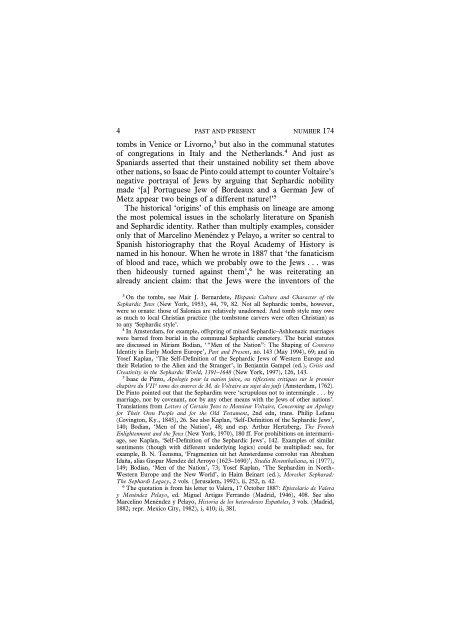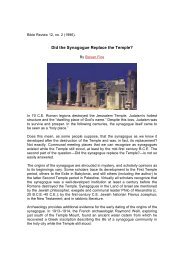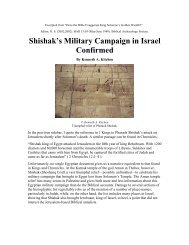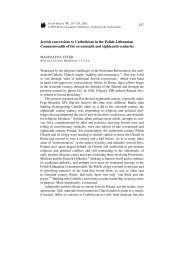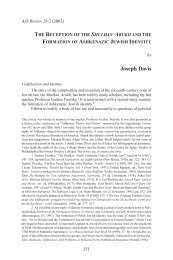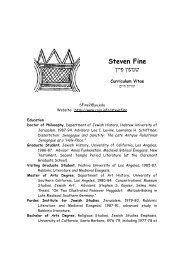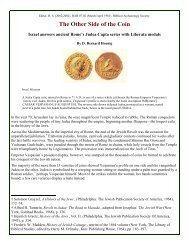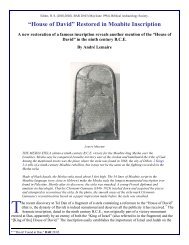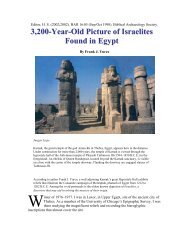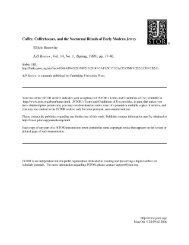jews and christians in fifteenth-century spain
jews and christians in fifteenth-century spain
jews and christians in fifteenth-century spain
You also want an ePaper? Increase the reach of your titles
YUMPU automatically turns print PDFs into web optimized ePapers that Google loves.
4 PAST AND PRESENT NUMBER 174<br />
tombs <strong>in</strong> Venice or Livorno,3 but also <strong>in</strong> the communal statutes<br />
of congregations <strong>in</strong> Italy <strong>and</strong> the Netherl<strong>and</strong>s.4 And just as<br />
Spaniards asserted that their unsta<strong>in</strong>ed nobility set them above<br />
other nations, so Isaac de P<strong>in</strong>to could attempt to counter Voltaire’s<br />
negative portrayal of Jews by argu<strong>in</strong>g that Sephardic nobility<br />
made ‘[a] Portuguese Jew of Bordeaux <strong>and</strong> a German Jew of<br />
Metz appear two be<strong>in</strong>gs of a different nature!’5<br />
The historical ‘orig<strong>in</strong>s’ of this emphasis on l<strong>in</strong>eage are among<br />
the most polemical issues <strong>in</strong> the scholarly literature on Spanish<br />
<strong>and</strong> Sephardic identity. Rather than multiply examples, consider<br />
only that of Marcel<strong>in</strong>o Menéndez y Pelayo, a writer so central to<br />
Spanish historiography that the Royal Academy of History is<br />
named <strong>in</strong> his honour. When he wrote <strong>in</strong> 1887 that ‘the fanaticism<br />
of blood <strong>and</strong> race, which we probably owe to the Jews . . . was<br />
then hideously turned aga<strong>in</strong>st them’,6 he was reiterat<strong>in</strong>g an<br />
already ancient claim: that the Jews were the <strong>in</strong>ventors of the<br />
3 On the tombs, see Mair J. Bernardete, Hispanic Culture <strong>and</strong> Character of the<br />
Sephardic Jews (New York, 1953), 44, 79, 82. Not all Sephardic tombs, however,<br />
were so ornate: those of Salonica are relatively unadorned. And tomb style may owe<br />
as much to local Christian practice (the tombstone carvers were often Christian) as<br />
to any ‘Sephardic style’.<br />
4 In Amsterdam, for example, offspr<strong>in</strong>g of mixed Sephardic–Ashkenazic marriages<br />
were barred from burial <strong>in</strong> the communal Sephardic cemetery. The burial statutes<br />
are discussed <strong>in</strong> Miriam Bodian, ‘ “Men of the Nation”: The Shap<strong>in</strong>g of Converso<br />
Identity <strong>in</strong> Early Modern Europe’, Past <strong>and</strong> Present, no. 143 (May 1994), 69; <strong>and</strong> <strong>in</strong><br />
Yosef Kaplan, ‘The Self-Def<strong>in</strong>ition of the Sephardic Jews of Western Europe <strong>and</strong><br />
their Relation to the Alien <strong>and</strong> the Stranger’, <strong>in</strong> Benjam<strong>in</strong> Gampel (ed.), Crisis <strong>and</strong><br />
Creativity <strong>in</strong> the Sephardic World, 1391–1648 (New York, 1997), 126, 143.<br />
5 Isaac de P<strong>in</strong>to, Apologie pour la nation juive, ou réflexions critiques sur le premier<br />
chapitre du VIIe tome des œuvres de M. de Voltaire au sujet des juifs (Amsterdam, 1762).<br />
De P<strong>in</strong>to po<strong>in</strong>ted out that the Sephardim were ‘scrupulous not to <strong>in</strong>term<strong>in</strong>gle . . . by<br />
marriage, nor by covenant, nor by any other means with the Jews of other nations’.<br />
Translations from Letters of Certa<strong>in</strong> Jews to Monsieur Voltaire, Concern<strong>in</strong>g an Apology<br />
for Their Own People <strong>and</strong> for the Old Testament, 2nd edn, trans. Philip Lefanu<br />
(Cov<strong>in</strong>gton, Ky., 1845), 26. See also Kaplan, ‘Self-Def<strong>in</strong>ition of the Sephardic Jews’,<br />
140; Bodian, ‘Men of the Nation’, 48; <strong>and</strong> esp. Arthur Hertzberg, The French<br />
Enlightenment <strong>and</strong> the Jews (New York, 1970), 180 ff. For prohibitions on <strong>in</strong>termarriage,<br />
see Kaplan, ‘Self-Def<strong>in</strong>ition of the Sephardic Jews’, 142. Examples of similar<br />
sentiments (though with different underly<strong>in</strong>g logics) could be multiplied: see, for<br />
example, B. N. Teensma, ‘Fragmenten uit het Amsterdamse convolut van Abraham<br />
Idaña, alias Gaspar Mendez del Arroyo (1623–1690)’, Studia Rosenthaliana, xi (1977),<br />
149; Bodian, ‘Men of the Nation’, 73; Yosef Kaplan, ‘The Sephardim <strong>in</strong> North-<br />
Western Europe <strong>and</strong> the New World’, <strong>in</strong> Haim Be<strong>in</strong>art (ed.), Moreshet Sepharad:<br />
The Sephardi Legacy, 2 vols. (Jerusalem, 1992), ii, 252, n. 42.<br />
6 The quotation is from his letter to Valera, 17 October 1887: Epistolario de Valera<br />
y Menéndez Pelayo, ed. Miguel Artigas Ferr<strong>and</strong>o (Madrid, 1946), 408. See also<br />
Marcel<strong>in</strong>o Menéndez y Pelayo, Historia de los heterodoxos Españoles, 3 vols. (Madrid,<br />
1882; repr. Mexico City, 1982), i, 410; ii, 381.


